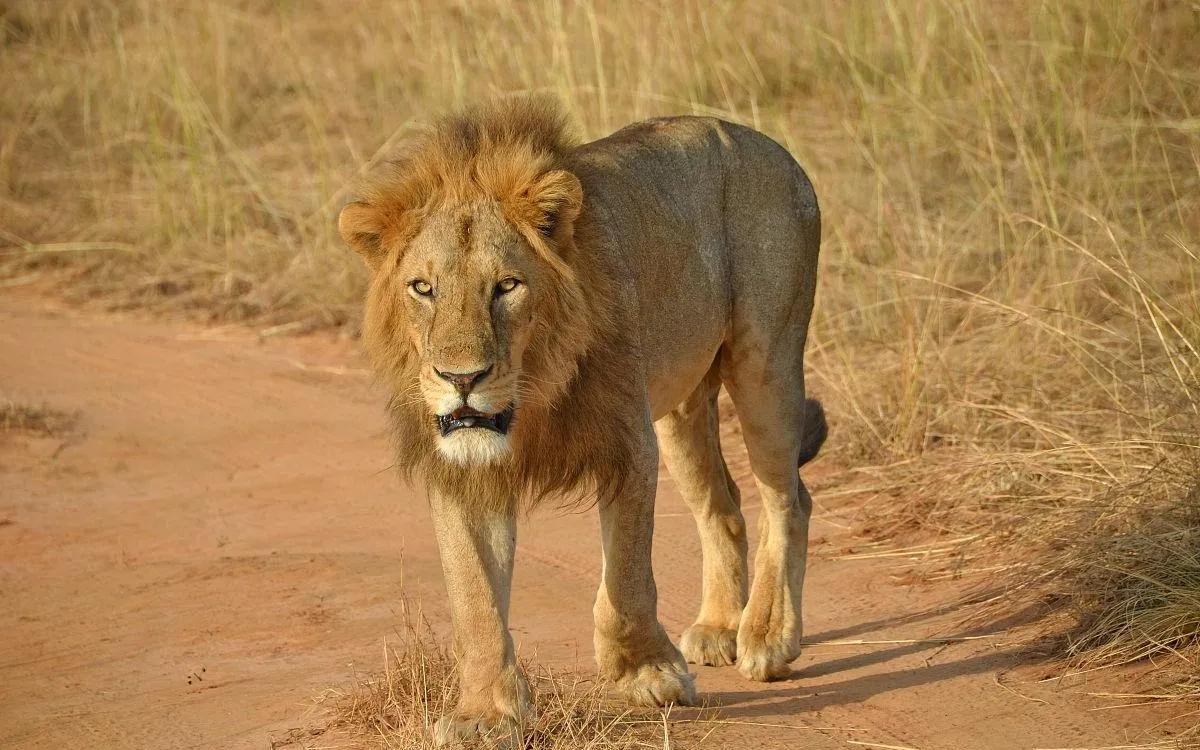Characteristics of Lion
Habitat
Grasslands and savannas of sub-Saharan Africa
Diet
Carnivore - large mammals like zebra, wildebeest, and buffalo
Lifespan
10-14 years in the wild, up to 20 in captivity
Weight
120-190 kg (males), 110-150 kg (females)
Length
170-250 cm including tail
Region
Sub-Saharan Africa, small population in Gir Forest, India
Lion Sound Characteristics
The lion sound, particularly the iconic lion roar, is one of the most distinctive animal sounds in nature. Lion sound varies from powerful roars to softer grunts, each serving different communication purposes.
Full Roar
The classic lion sound is the full territorial roar, used to announce presence and warn other lions. This powerful lion sound can be heard up to 5 miles away, making it the loudest sound produced by any living cat species.
40-200 Hz
114 decibels
30-60 seconds
Most commonly at dawn and dusk when lions are most active
Growl
A lower, threatening lion sound used during confrontations or when warning others. The lion growl is a critical part of the lion sound repertoire for close-range intimidation.
35-150 Hz
80-95 decibels
2-10 seconds
During territorial disputes or when protecting cubs
Grunt
Softer lion sound used for close communication between pride members. These gentle lion sound help maintain social bonds within the pride.
50-150 Hz
65-75 decibels
1-3 seconds
During social interactions, especially between females and cubs
Snarl
A sharp, aggressive lion sound made with exposed teeth. This distinctive lion sound serves as an immediate threat display.
60-200 Hz
85-100 decibels
1-5 seconds
During fights over food or when threatened
Moan
A softer, prolonged lion sound used to locate other pride members. This lion sound helps scattered pride members find each other in the savanna.
40-120 Hz
70-85 decibels
2-8 seconds
When separated from the pride or calling to cubs
Interesting Lion Sound Facts
The lion sound we recognize as a roar is actually a series of grunts that build up in volume and intensity
Only adult lions can produce a full roar - cubs make softer lion sound until they mature
The lion sound of a roar is created by unique vocal fold structures not found in smaller cats
Female lions also roar, though their lion sound is typically slightly higher in pitch than males
Lions often roar in chorus, creating a symphony of lion sound that intimidate rivals and strengthen pride bonds
Interesting Facts about Lion Sound
A lion's roar can be heard from up to 5 miles (8 kilometers) away
Male lions can sleep up to 20 hours a day
Lions are the only cats that live in groups, called prides
Female lions do 85-90% of the pride's hunting
Lions can run for short distances at 50 mph
A lion's heels don't touch the ground when it walks
FAQs about Lion Sound
Find answers to all your questions about Lion sounds
Q What does a lion sound like?
A lion sound is characterized by deep, powerful roars that can be heard up to 5 miles away. The lion sound repertoire also includes growls, grunts, moans, and snarls. The most iconic lion sound - the full roar - begins with a series of soft grunts that build into a thunderous, intimidating vocalization lasting up to a minute.
Q Why do lions roar at night?
Lions produce their distinctive roaring sound at night primarily to communicate over long distances. This lion sound serves multiple purposes: marking territory, intimidating rivals, and helping separated pride members locate each other. The night air carries the lion sound farther, making evening roars more effective for long-distance communication.
Q What is the difference between a lion sound and a tiger sound?
While both are big cat sounds, a lion sound (roar) is deeper and more resonant than a tiger sound. The lion sound carries farther across open savannas, while tiger sounds are adapted for forest environments. Lion sound also often occurs in chorus with other pride members, unlike the typically solitary tiger sound.
Q Can female lions make the same sound as males?
Yes, female lions can produce the same type of lion sound as males, including the full roar. However, the female lion sound is typically slightly higher in pitch and may not be quite as loud as the male lion sound. Both sexes use these lion sound for territorial communication and pride coordination.
Q How do lion cubs sound compared to adults?
Lion cubs cannot produce the full lion roar sound until they mature. Young lions make softer lion sound like mews, squeaks, and small growls. These juvenile lion sound gradually develop into the characteristic adult lion sound repertoire as their vocal anatomy develops, usually reaching full roaring capability around 2-3 years of age.
Q What does a mountain lion sound like compared to an African lion?
Despite the name similarity, the mountain lion sound is completely different from an African lion sound. Mountain lions (also called cougars) cannot roar and instead make high-pitched screams and whistles. The African lion sound of a full roar is much deeper and more powerful than any mountain lion sound.
Q How do lions use different sounds to communicate?
Lions have a sophisticated repertoire of sound for different situations. The loud roaring lion sound establishes territory and locates pride members. Softer lion sound like grunts maintain social bonds. Warning lion sound like growls and snarls signal aggression or protect resources. Cubs make distinctive lion sound to solicit care from adults.
Q What equipment is used to record lion sounds?
Professional lion sound recordings require specialized equipment including directional microphones with wind protection, high-quality field recorders, and often camera traps with audio capabilities. Wildlife sound recordists capture authentic lion sound samples by setting up near watering holes or known pride territories, sometimes waiting days for the perfect lion sound.
Most Downloaded mammals Animal Sounds
Discover our most popular mammals animal sounds
